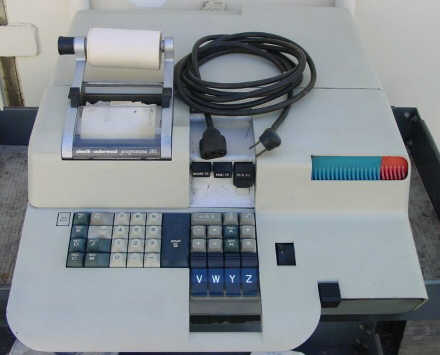

| +Calculators | Wanted | Advertising | Articles | Links |

Olivetti Programma 101 Electronic Calculator
Updated 12/24/2002
The Old Calculator Web Museum is proud to announce that it has acquired an Olivetti Programma 101 calculator. The machine has arrived safely from its journey to the museum. Upon visual inspection, the calculator is in good physical condition, with a few minor issues. One is that some parts of the power switch 'push-on/push-off' assembly are missing. Also, one of the buttons that controls the magnetic card reader is missing. One of the rubber rollers that helps to drive the magnetic cards through the card reader has decomoposed somewhat, which will be a bit of a challenge to repair. The main logic cage seems to be in good shape..all of the logic cards are present, and there are no signs of any catastrophic component failure. The wiring harnesses are all in good condition, with no indications of chafing or overheating. The power supply assembly seems sound, with no signs of overheated or blown components. The keyboard assembly, which is mechanically encoded, is somewhat gummed up and will require a good cleaning and lubrication. Likewise, the drum printer assembly is also somewhat gummy and will require cleaning and lubrication before operation of the machine can be attempted. All of the rubber belts that link up the main motor that drives the printer, card reader, and forced air cooling system are in serviceable condition, which is quite amazing given the age of the machine. The magnetostrictive delay line shows no sign of external damage (it is a sealed assembly), and the circuit board that provides the drive for the delay line also looks good on visual inspection. The cabinetry (all cast metal) is in good condition, with the original paint a bit oxidized from age.
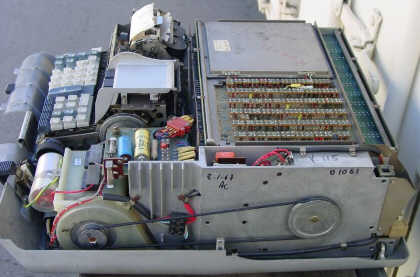
An Internal View of the Programma 101
The next steps in the resurrection of the machine will involve complete cleaning of the keyboard, printer and magnetic card reader assemblies. Then, the power supply will be completely checked out (while disconnected from the logic chassis), to assure that capacitors have not malformed due to age, and that all components are operating properly. The main drive motor and belts/pulleys that link the drive motor to the card reader, cooling fan, and printer assemblies will then be checked out. The chassis and cabinet components will be thoroughly cleaned. All circuit boards will be removed from the logic chassis, inventoried, and a more complete visual inspection given to assure that there are no obvious problems.
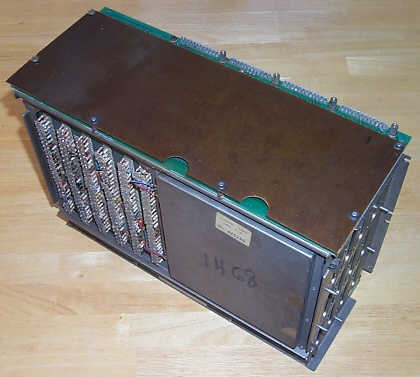
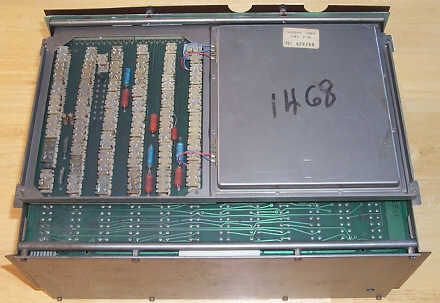
Two Views of the Logic Chassis of the Programma 101
Edge connector fingers will be cleaned, and any electrolytic capacitors (power supply bypass capacitors) checked to assure that no shorts have developed. Once all is checked out, the machine will be carefully re-assembled, and power applied. If lucky, the machine will operate properly. Given the age of the machine, though, it's probable that some components have failed, which may cause the machine to malfunction. In such case, it will be a tedious matter to tracking down the failed components, and hoping that suitable replacements parts can be found. This page will be updated as the project moves to completion.
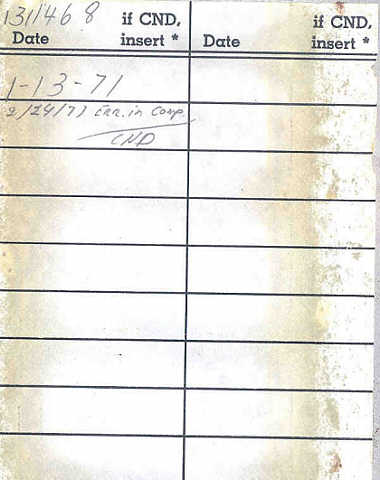
Service Tag found on the logic chassis of the Programma 101
The museum's Programma 101 is serial number 1311468, and appears to have been manufactured in the late part of 1969. Each of the eight 13 1/2" by 9 1/2" main logic boards is marked with a date, which ranges from late October to late November, 1969. A service tag found inside the machine indicates some unspecified service was performed in January of 1971, and another service to the main logic chassis was performed in February of 1971. Initial sales price for the Programma 101 when it was introduced to the U.S. Market in early 1966 was $3200.
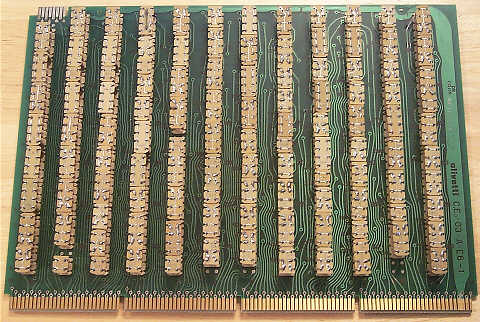
One of the 8 Main Logic Boards of the Programma 101
The Olivetti Programma 101 is considered a watershed machine in the history of electronic calculators. Though considered by many to be the first monolithic desktop stored-program programmable electronic calculator, this distinction is questionable. It appears that the Mathatronics Mathatron calculator preceeded the Programma 101 to market. However, the Programma 101 was produced in much greater quantities, and had much more exposure than the Mathatron. Even if the Programma 101 wasn't the first of its kind, it still has a major place in calculator history.
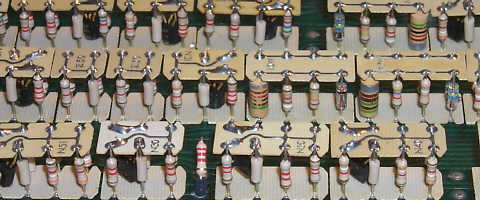
The "Tinker-Toy" Logic Modules
The design of the Programma 101 began in 1962, making it one of the earliest designs for an integrated desktop stored program calculator. At the time, the only electronic calculator on the market was the Anita C/VIII, a very simple desktop four-function calculator that used thyratron tube technology. The Programma 101 was an aggressive design, utilizing computer-like transistorized logic modules, a large-capacity magnetostrictive delay line for working storage, a magnetic card reader/writer (technology that Hewlett Packard had to pay royalties to Olivetti for when HP began selling their 9100 calculators), and an integrated 30-column drum impact printer for recording the results of calculations. The circuit board technology used in the machine was ahead of its time, with traces on both sides of the boards that utilized plated-through feedthroughs. Miniature "tinker-toy" modules which form circuit assemblies are populated on the circuit boards. These modules were placed so that two circuit boards could be placed component-side to component side, and the modules would neatly enmesh, allowing high component density in a comparatively small space.

The "interleaved" circuit board layout provides for high component density
The resulting machine, introduced in late 1965, was a work of art from many perspectives. The electronics design of the machine was brilliant, with genius of its inventor, Pier Giorgio Perotto(1930-2002) showing in all aspects of the logic design. Functionally, the calculator was quite easy to use and very capable, making it a hit among educational institutions as the choice for early computer education. The ease of use, programmability, and personal nature of the machine led it to be designated as the first "Personal Computer", years before the IBM PC existed! Aesthetically, the famous Italian designer Mario Bellini developed the stunning cabinet design of the machine, which won countless industrial design awards and still looks artfully stylish even by today's standards. Altogether, the Programma 101 stood as the premier programmable desktop calculator until Hewlett Packard introduced its 9100A calculator in 1968. The fact that the Programma 101 was a design which was class-leader for almost three years, during such a period of dramatic growth in the electronics industry, gives clear insight to the engineering excellence of this calculator.
Some time was found yesterday to do a checkout of the main drive motor and power supply. After checking the mains supply resistance, it seemed that all was OK. Power was applied to the system (with the electronics package removed), and the drive motor powered up just fine, and the power supply seems to be operating properly. The noise that the machine makes is substantial, with the main drive motor, two squirrel-cage fans for cooling (one for the motor itself, and another that cools the electronics through built-in duct work), and the mechanical components that operate the printer and magnetic card reader all contributing to the noise of the machine at idle. The inside of the cabinet is covered with felt sound-deadening material, but even with the cabinetry in place, the machine is still quite noisy. I can imagine that the noise increases dramatically when the printer is active, since it is an impact style printer. The next steps will be to perform measurements of the power supply voltages, and checking of power supply ripple using an oscilloscope.
Watch this pre-exhibit for updates on the status of the exhibit as information becomes available.